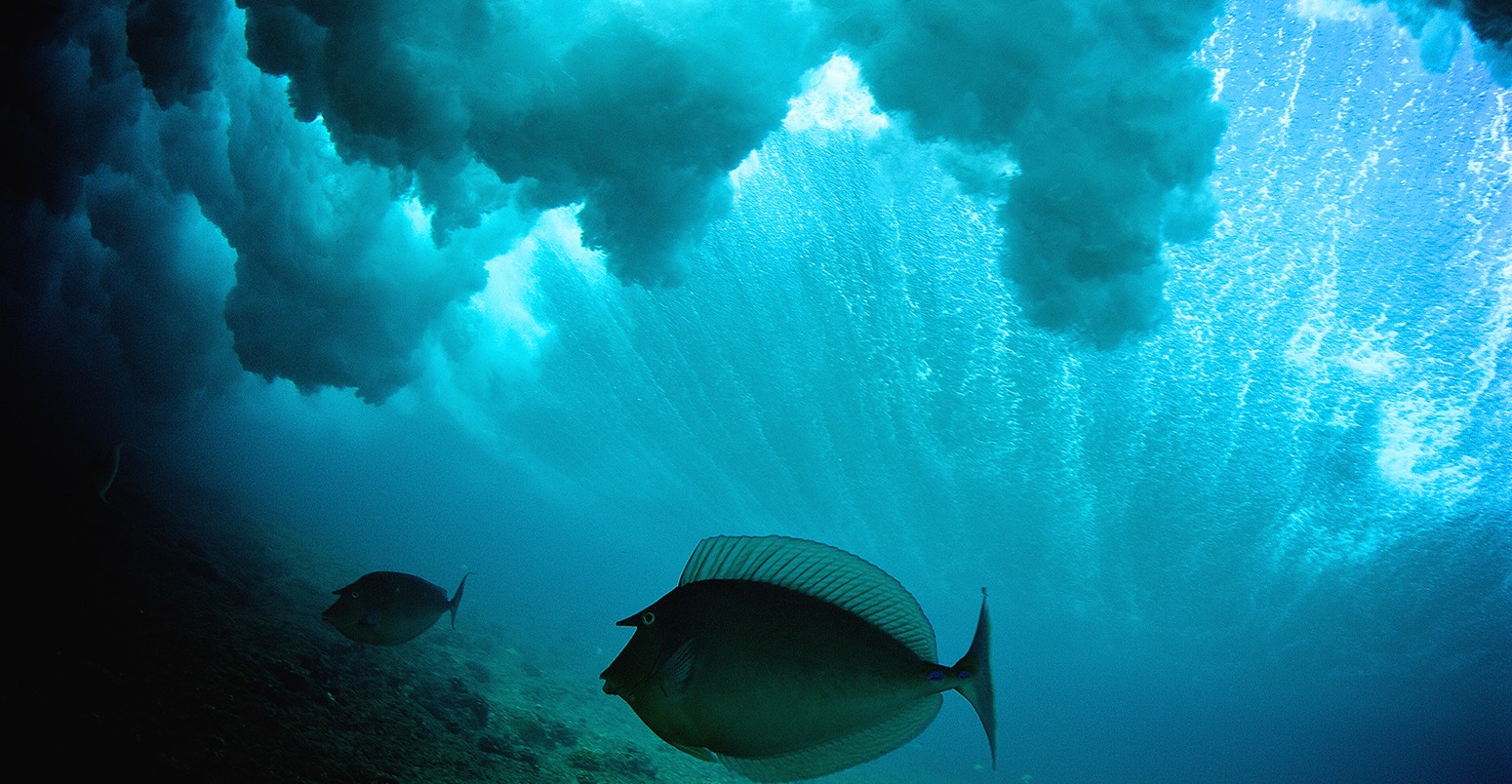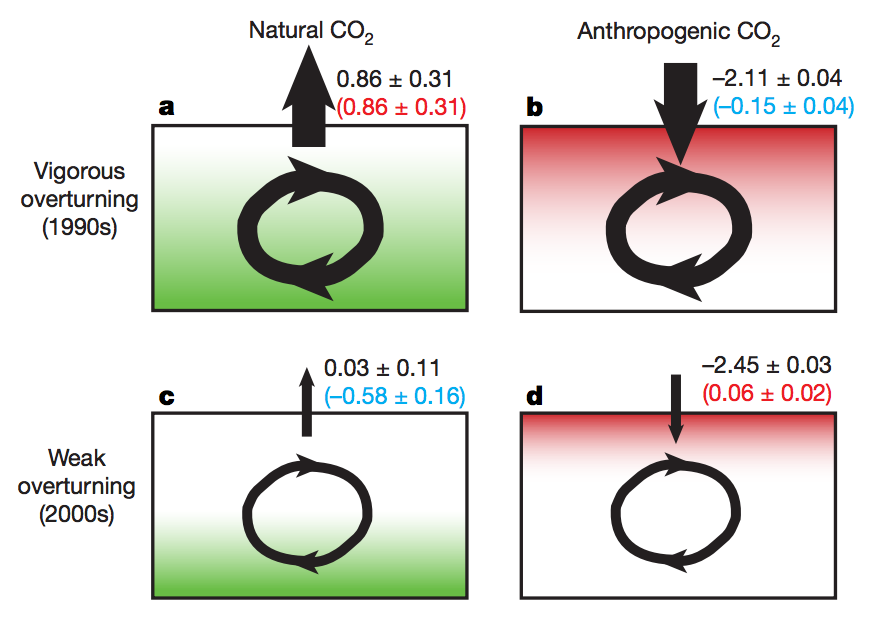
The oceans are a hugely important “carbon sink”, helping absorb CO2 emissions from human activities. Without them, CO2 would accumulate more quickly in the atmosphere, raising temperatures more quickly.
A new study, published in Nature, finds that recent changes in circulation patterns in the world’s oceans are playing a key role in how much CO2 they take up.
Weakening circulation patterns have boosted how much CO2 the oceans absorb since the 2000s, the researchers say, but there’s no guarantee that this will continue into the future.
Circulation patterns
The Earth’s oceans have absorbed about a third of the CO2 that humans have emitted into the atmosphere since the beginning of the Industrial Revolution.
But the amount of CO2 that the oceans absorb isn’t constant. In the 1990s, ocean CO2 uptake dropped off, before increasing again in the 2000s. Recent research shows that the Southern Ocean was central to these changes.
The Southern Ocean is the most prolific of the oceans for carbon storage – accounting for approximately 40% of the global ocean CO2 uptake. In the 1990s, strengthening winds circulating around Antarctica affected ocean currents and brought carbon-rich water to the surface. This meant the ocean was less able to absorb CO2 from the atmosphere.
In the 2000s, the winds continued to strengthen, yet the CO2 uptake in the Southern Ocean rebounded. This, combined with increasing CO2 uptake in other oceans, suggested to scientists that there was, ultimately, another factor affecting the ocean carbon sink.
The new study says the reason lies in circulation patterns in the top 1,000m of the world’s oceans.
‘Missing piece of the puzzle’
The water in our oceans is constantly on the move. In the upper layers of the ocean there are several driving forces responsible, explains lead author Dr Tim DeVries, an assistant professor in oceanography at the University of California. He tells Carbon Brief:
“The [circulation patterns] are driven by winds and by ‘buoyancy forcing’ – which means changes in the density of surface waters due to changes in their temperature (heating/cooling) or salinity (adding/removing freshwater).”
Using observed data, the researchers built a computer model to simulate these circulation patterns in the upper ocean. They ran their model to analyse the exchange of CO2 between the ocean and atmosphere over recent decades.
They found that in the 1990s, the ocean circulation patterns were “more vigorous” and coincided with a big dip in CO2 uptake. From around 2000, the circulation patterns then weakened, bringing a rebound in CO2 uptake.
The simplified diagram below illustrates the effect these “overturning” circulation patterns have.
Stronger ocean overturning – as seen during the 1990s – brings more carbon-rich water up from the deeper ocean, the researchers say. When this water reaches the surface it releases CO2 into the atmosphere (see a). More vigorous overturning also means the ocean takes up more CO2 from the atmosphere (b), but not as much as the extra CO2 released.
As the bottom half of the diagram shows, weaker overturning in the 2000s reduces both the amount of CO2 released to the atmosphere (c), and what is absorbed again (d). Overall, this increases how much CO2 the ocean takes up.

Simplified conceptual diagram illustrating how changes in upper-ocean overturning circulation have affected the ocean CO2 sink. Figure shows the a) increased release and b) increased uptake of CO2 during the 1990s – with an overall reduced CO2 sink, and the opposite in the 2000s (c and d). Data show uptake/release of carbon (black) and the difference caused by the circulation change (red/blue), in billion tonnes of carbon. Source: DeVries et al. (2017)
The results show that fluctuations in upper ocean circulations are “absolutely the driving force in the variability of ocean CO2 uptake”, says DeVries.
In an accompanying “News & Views” article, Dr Sara Mikaloff-Fletcher, from the National Institute of Water and Atmospheric Research in New Zealand, agrees. She writes:
“[The paper] is the first to robustly quantify the role of circulation change in the recent decadal shift in CO2 uptake, providing the missing piece of this puzzle.”
‘Major advance’
The paper is a “major advance” in the understanding of changes in the ocean carbon sink, says Mikaloff-Fletcher, but it isn’t able to give us any clues for the future:
“It remains unclear for how long the increased carbon uptake observed during the 2000s will persist.”
In general, scientists expect that as CO2 levels increase in the atmosphere, more will dissolve into the ocean. DeVries explains:
“The rate at which CO2 is transferred from the air into seawater depends on the difference in the concentration of CO2 in the air, and that in the water. So, as humans put more CO2 in the atmosphere, this concentration difference increases, and the ocean absorbs more CO2.”
If the weak circulation patterns continue, this “may help to enhance the oceanic CO2 sink for some time”, the paper says. But there is also the distinct possibility that the changes we are seeing now are temporary, says DeVries:
“The overturning circulation [could] switch back to a more vigorous state in the next decade. In this case, the changes would be reversed, and we would go back to a weaker ocean CO2 sink (like in the 1990s).”
This would lead to a faster accumulation of carbon emissions in the atmosphere – and more rapidly-increasing temperatures.
Human-caused warming
The researchers don’t yet know whether the recent weakening of the ocean circulation patterns are caused by natural variability or human-caused warming.
Global warming is expected to have a similar weakening effect on the circulation patterns as has been seen since the 2000s, DeVries says:
“Human CO2 emissions cause warming…of the surface ocean and makes it less dense. At the same time, the warming melts glaciers and ice caps, which pour fresh water into the ocean. This also makes the surface waters less dense. As surface waters get lighter, they are less likely to sink. This weakens the overturning circulation.”
However, at the moment, it’s likely that natural variability in the oceans is the dominant factor, says Prof Nicolas Gruber, professor of environmental physics at ETH Zürich, who wasn’t involved in the study. He tells Carbon Brief:
“My working hypothesis is that it is natural variability, but only time will tell. I say this because model simulations suggest that the point where the human-caused impact on the ocean carbon sink is clearly separable from natural variability is rather distant in the future.”
DeVries, T. et al. (2017) Recent increase in oceanic carbon uptake driven by weaker upper-ocean overturning, Nature, doi:10.1038/nature21068 Mikaloff-Fletcher, S.E. (2017) Ocean circulation drove increase in CO2 uptake, Nature

